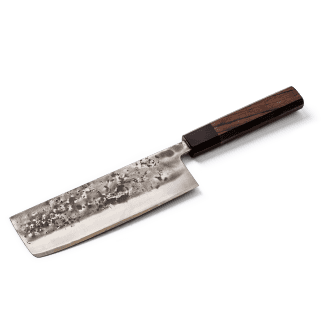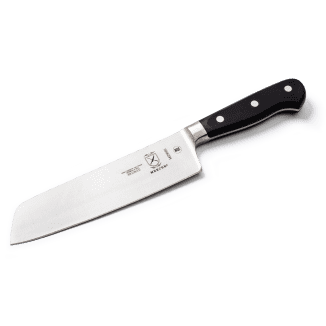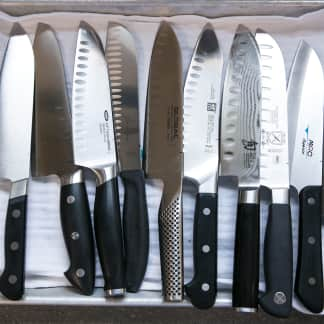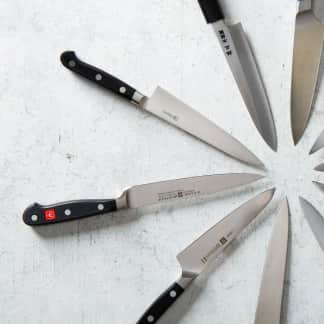The nakiri bōchō, or nakiri, was traditionally one of the most important knives found in Japanese home kitchens. Translated roughly, nakiri bōchō means “leaf-cutting knife”; it’s meant for slicing, dicing, and chopping vegetables, which form the backbone of Japanese cuisine. It has a rectangular blade with a relatively straight double-beveled edge and a blunted tip. The edge allows you to maximize contact with the cutting board, so you can chop large bunches of leeks or carrots more efficiently. As the blade is fairly straight, you cut in a more-or-less up-and-down motion, using simple push or pull cuts instead of rocking the blade from tip to heel, as you would with a Western knife. Relatively tall from cutting edge to spine, the blade is also great for keeping large foods or piles of greens in line as you work your way through them, allowing you to make perfectly straight, even cuts. It’s also good for scooping up the cut food when you’re done with it.
Because of its rectangular blade, the nakiri is often incorrectly labeled as a vegetable cleaver in Western markets (and in one of our previous reviews). The term “cleaver” is misleading, as it implies that this knife can be used for what we might call abuse tasks, such as hacking through chicken wings or chopping tough squash or pumpkin. It can’t! Like all Japanese knives, the nakiri is typically made of very thin, very hard, and fairly brittle metal; it should not be used to hack, twist, or force its way through tough or hard food, or it will chip.



We wanted to know which nakiri was best for home cooks, so we bought 12 models, priced from about $48 to about $255. We focused on nakiri with blades ranging from 6 to 7 inches in length—the most common size—and included both stainless-steel and carbon-steel models, using each to dice onions, mince parsley, julienne peppers, chop greens, brunoise (very finely dice) carrots, slice cabbage, slice delicata squash, and slice partially frozen steaks.

Blade Design Is Key
Most of the models were sheer pleasure to use. They dispatched vegetables small and large with aplomb, making quick work of produce prep. But a few design factors separated the models we liked from those we didn’t. While blades closer to the 6-inch end of the spectrum provided a little more control and precision when dicing onions or making brunoise, we ultimately preferred knives that were a touch longer, as they gave us more command over a greater range of vegetables, allowing us to slice wide swaths of greens or big peppers in a single stroke.
We also liked blades that were relatively tall from cutting edge to spine, as they made it easier to corral heaps of parsley and slice tall cabbages cleanly and evenly. These taller blades also had more surface area for scooping up and transporting the cut food when we were done.


We liked blades that were thin from edge to spine as well. Blades with thicker spines often wedged into food instead of cutting it. This was occasionally a benefit—having a little weight at the top of the blade made it easier to power through dense delicata squash. But most of the time, blades with thick spines made it harder to cut peppers and cabbage into thin slices, and they felt clumsier and less nimble when making tiny brunoise—more like small axes than knives. Thinner blades, by contrast, consistently made perfect, precise cuts.

Blade Material And Finish Is Up To You
We didn’t have a preference for one type of metal over another. Some of the models we loved had stainless-steel blades, and others had carbon steel. Carbon-steel knives have a reputation for being high maintenance, requiring some care to prevent rust from forming on their surfaces. But the blades of the carbon-steel nakiri that we tested were clad in stainless steel, meaning that their faces were almost entirely stain-resistant and only their exposed cutting edges are prone to rust. We found these knives to be easy to maintain; as long as we wiped them dry after each task, we had no issues.
We had no preference when it came to the finish of the knife either. Three of the blades had tsuchime, or hammered, finishes—dimples beaten into the surface of the blade during the final stages of the knives’ construction. We were intrigued; not only was this finish pretty, but we’d been told that the dimples would act somewhat like the grantons found on slicing knives, reducing the friction between blade and food and allowing the food to release more easily. In practice, however, we didn’t notice any functional advantages; vegetables slid off knives with tsuchime about as easily as they did on those without.

Weight Is Critical
One thing that did matter was the weight of the knives. We found that we greatly preferred lighter nakiri, perhaps in part because the design of the blade requires you to repeatedly lift the knife while chopping in more of an up-and-down motion—a cycle that can cause your arm to fatigue a little more quickly with heavier models, especially during longer prep sessions. For the most part, the weight of any knife depends on the amount of metal in it. The thinner the blade and the shorter and narrower the tang—the part of the blade that sticks into the handle (see "Buying a Knife? Consider the Handle, Not Just the Blade")—the less metal there is and the lighter the knife will be. The models we liked best weighed about 5 to 6 ounces and had thin blades with tangs that extended about halfway into the handle. Our least favorite models weighed nearly twice as much and had thicker blades and full tangs.
Handle Material Is Important
When it came to handles, the material was key: We liked handles made from materials that had a bit of texture to them. Unvarnished wood handles do require a little care to maintain—because the wood is left raw, you’ll need to apply oil from time to time to prevent water from getting in and damaging or cracking it. But they were easy to grip and warm and responsive in our hands; metal, plastic, and composite handles were occasionally a bit slick.

The Best Nakiri: Masamoto Sohonten Wa Nakiri, Sakai Kikumori 165mm Nakiri Aogami 2 Nashiji, And Masutani Vg1 Nakiri 165mm
We loved using the majority of these knives and think most home cooks would, too. However, a nakiri might not completely replace your trusty chef’s knife or santoku. Because most nakiri have a snub, rounded tip instead of a pointy one, it’s harder to do fine detail work such as making tiny, shallow incisions (mincing shallots or garlic, for example). Still, we think the nakiri could certainly give your main blade a run for its money—we loved using them whenever we had a pile of produce to whittle down for dinner. And despite its historical origins, your use of a nakiri needn’t be limited to vegetables; we found that most of the models also excelled when used to cut raw steak into paper-thin slices for bulgogi. We’d just recommend against using the nakiri on anything hard, such as bones, big squash, or completely frozen food.
While we liked many of the nakiri we tested, a few stood out. We think that the Masamoto Sohonten Wa-Nakiri is the best nakiri for most cooks. It was the lightest model we tested, feeling nearly weightless in our hands. Its stainless-steel blade made cutting a breeze, and its wood handle was pleasant to hold. If you prefer carbon-steel knives, the Sakai Kikumori 165mm Nakiri - Aogami 2 - Nashiji came in a close second place. It’s nearly as light as the Masamoto Sohonten model, its blade is the same length, and its octagonal wood handle was especially easy to grip. Neither of these nakiri are cheap, however; they both cost more than $200. For a less expensive option, we also loved the ultralight Masutani VG1 Nakiri 165mm, which costs about $70. While its polished wood handle was a little slippery, it was still very comfortable to hold. And although its blade is a bit narrower than those on the other two knives, it was also the thinnest we tested, so it practically flew through produce.
The Tests
- Dice onions
- Mince parsley
- Julienne peppers
- Brunoise carrots
- Slice cabbage
- Slice greens
- Slice delicata squash
- Slice partially frozen steaks
- Evaluate each knife’s sharpness using an industrial sharpness-testing machine at the beginning and end of testing
How We Rated
- Blade: We evaluated the design of the blade and how it contributed to the knife’s ability to cut foods evenly and precisely.
- Handle: We evaluated the design of the handle and how comfortable it was to hold and grip.
- Weight: We rated the knives on their weight and how easy they were to use for long periods.
- Thin blade of moderate length and height that enables precise cuts and good command over larger foods
- Lightweight, so it’s easy to use for extended periods
- Handle made with textured material that’s easy to grip


 Buy at Korin
Buy at Korin












 Buy at Made In Cookware
Buy at Made In Cookware






